Arundo (1/2)
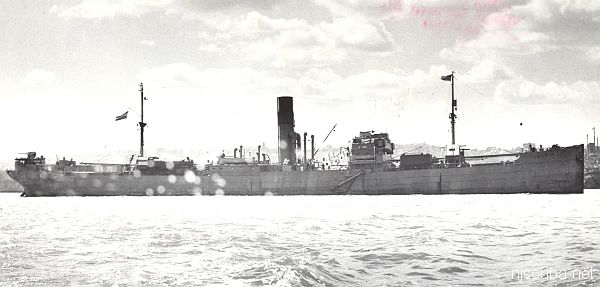
Note the locomotives on deck, foreward of the aft mast.
- Type:
- shipwreck, freighter, Netherlands
- Built:
- 1930, New Castle England, as Petersfield
- Specs:
- ( 412 x 55 ft ) 5163 gross tons, 43 crew
- Sunk:
- Tuesday April 28, 1942
torpedoed by U-136 - 6 casualties - Depth:
- 140 ft max; 110 ft min; 125 ft typical
In a daring shallow-water attack, a single torpedo from the U-136 tore open the starboard side of the Arundo just below the bridge and blew off the hold covers. The stricken ship heeled over to starboard and sank in only five minutes. Survivors of the attack were soon picked up by nearby vessels, but her cargo of war materiel outward-bound for the campaign in North Africa never made it there. That cargo included jeeps, big 10-wheeled army trucks, 2 locomotives, and 5000 cases of Canadian beer. After the war the Arundo was wire dragged and otherwise demolished, and her exact location was lost. There are several other wrecks in close proximity which have all gone under the name Arundo until the true Arundo was finally re-identified.
What remains of the real Arundo is more a vast debris field than a ship, although some parts are still tall and almost recognizable. The highest parts near the bow are at about 110 ft, but the bulk of the wreck is at 120-130 ft, and the stern goes down to 140 ft at the sand. This is not a dive for the faint-hearted. You can expect a long boat ride to cold, silty, dark conditions in the Mud Hole, and the depth of this site is going to require a considerably higher level of experience and equipment than most others, and should only be attempted by those who are realistically prepared. The Arundo is also heavily fished and offers myriad ways for the unwary diver to get entangled in the usually poor visibility. This is a two-knife double-tank decompression dive.
If you are willing and able, what you will find is amazing. By way of comparison, imagine the Mohawk, but twice as big and twice as deep. Or better yet, imagine the Algol with a full cargo, exploded all over the place. I was told the bow juts up with two huge anchors still attached and is very impressive, so I got directions and set out to find it on the second dive. Well, I must have taken a wrong turn, ** because I went out to the end of a 300 ft wreck reel, and I never saw a bow, or an anchor, or an end to this enormous wreck.

** Since the directions involved "taking a left turn from the anchor line", and I suspect that the current had reversed between the first and second dive, I probably ended up going back to the stern rather than up to the bow. I have seen this kind of reversal happen on the Algol. Always get compass bearings!
Everywhere there are large truck tires, some still mounted in eight-wheel sets to double-axle truck differentials, others crated together or just lying around. Much other debris is scattered all over, and in many places, the walls of the hull still stand high out of the sand. One of the locomotives lies off the wreck in the sand; the other resembles an overly long, narrow boiler. Most of the parts having rusted away. At right is a drive wheel.
There is a seemingly never-ending supply of unbroken but rather ordinary one-quart clear glass beer bottles for collectors of such things. These bottles are filled with the foulest-looking black muck. In fact, every part of this wreck seems to be covered in filth and sediment ( as if there is such a thing as a clean wreck ! ) and the overall conditions are rather dark and dreary, even on a good day.
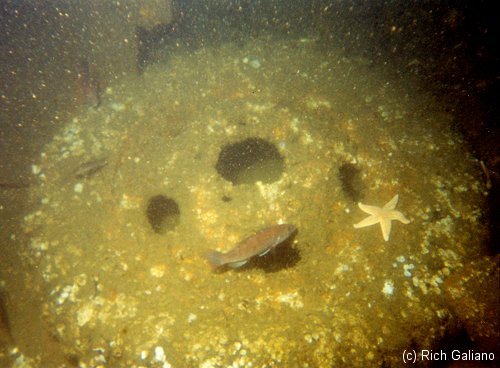
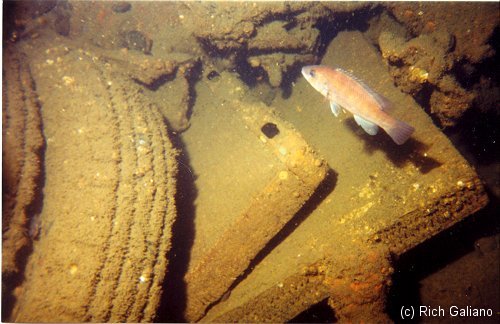
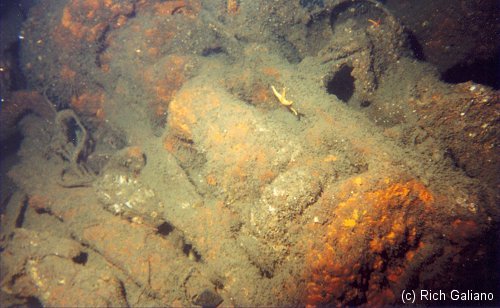
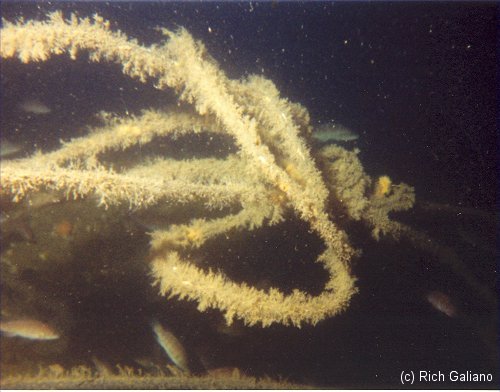
The Arundo is not really known as a lobster wreck, although it produces a few. There are also mussels, but they are very dirty. Fish life is dominated by large ling and winter flounder.
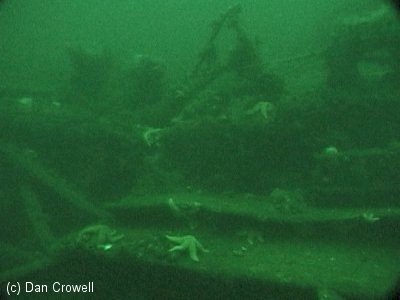
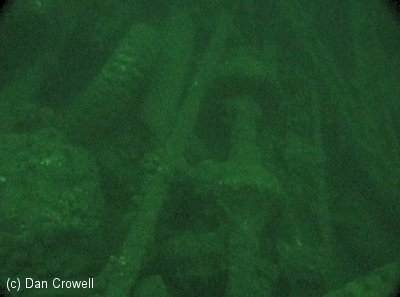
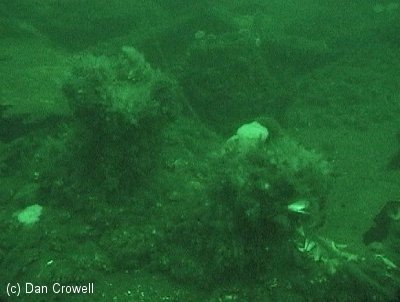
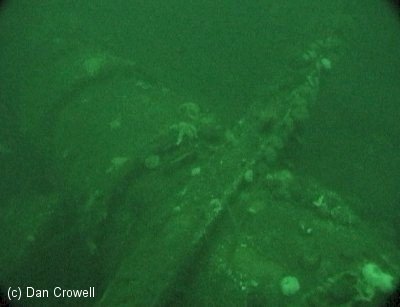
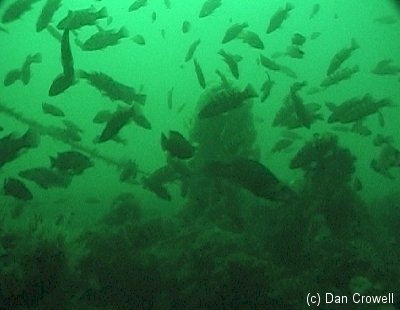
Courtesy of Dan Crowell
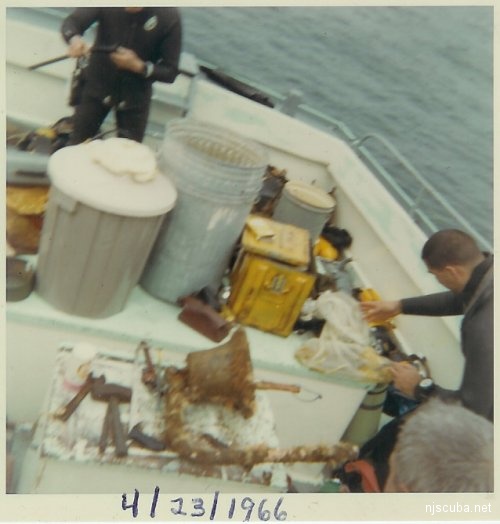
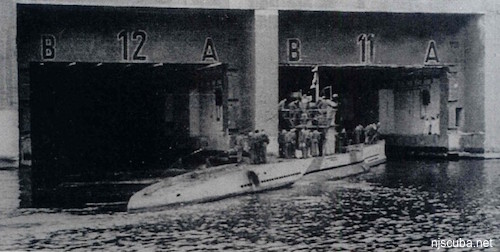
SALVAGE OF SHIP OFF JERSEY BEGINS
Mystery Cargo, Worth Millions, Sought On Freighter Sunk by U-Boat in 1942
Special to The New York Times
ASBURY PARK, N.J. Nov. 14 (1945)
-- One of the first ambitious post-war salvage operations began here today when workmen of the Diamond Salvage Company of Washington began setting up their rigs to salvage the lost Netherlands freighter Arundo, which went down off the coast in April 1942, after a torpedo hit her.
Robert Hansen of Middletown, N.J., who is in charge of the operation headquarters that has been established near here, is said to be ready to employ new-style diving equipment and the most Modern salvage apparatus available. The method to be used in attempting to raise the vessel from its resting place in 150 feet of water will be decided on after surveys with the diving equipment.
The 5,163-ton 412-foot vessel lies about fifteen miles off Asbury Park, and the little salvage auxiliary craft Eleanor is already in position overhead. A big salvage vessel is on the way today from Cape May.
Something of an aura of mystery surrounds a part of the cargo. The Arundo, operated by the British Ministry Of War Shipping, sailed out Of New York on April 28 with a full general cargo and a crew of forty-three men. She went to sea during the worst weeks of the submarine menace, when marauding German U-boats were roaming off the coast and even entering harbor mouths to pick off helpless craft.
The Arundo that night got only as far as a position off Atlantic City -- Latitude 40°10' North, and Longitude 73°44' West, to be exact -- when a torpedo tore into her side. Six men were lost and the thirty-seven survivors were picked up the next day and landed at Lewes, Del, by a naval search vessel.
Onboard were many trucks and automobiles, tires, and two diesel-engine locomotives worth several million dollars. In addition, there was a shipment of "valuable instruments" of an unidentified nature, but despite the valuable nature of the other cargo, these instruments, according to salvage men who have talked about the job here, were worth more than the rest of the shipment, all of which was destined to the Allied Middle East Command at Alexandria.
Speculation about the mysterious cargo of instruments is rife here. Perhaps it was radar equipment, or air detection material, the arrival of which might have speeded up the victory over the Axis African forces. No one knows, but the implied worth of the cargo, bringing a salvage attempt in such deep waters, whets the imagination.
The actual diving headquarters has been set up on Avon Fishing Pier, two miles south of Asbury Park. Most advance experts setting up the equipment are close-mouthed about the operation, and no one has yet hazarded a guess as to how long it will take.

Questions or Inquiries?
Just want to say Hello? Sign the .